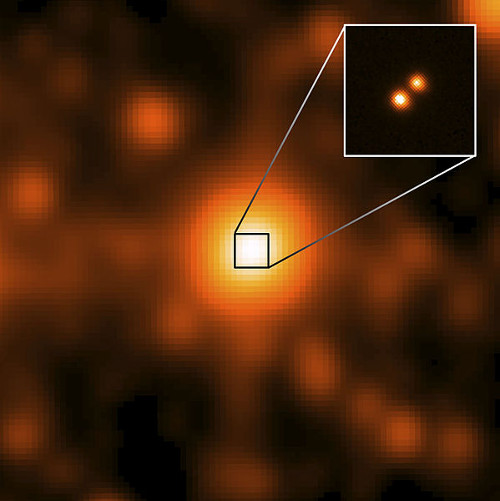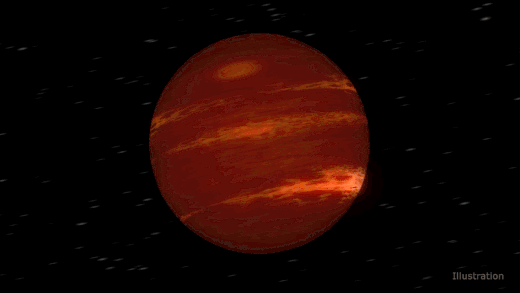I often think of brown dwarfs in terms of the planets that might form around them, and the question of whether even these small ‘failed stars’ may be capable of sustaining life. Have a look, for example, at Luhman 16AB, two brown dwarfs in the Sun’s immediate neighborhood. There are some indications of a planet here which, if it were ever confirmed, would make it the second closest known exoplanet to the Earth, at least for now. We can rule out planets of Neptune mass or greater with a period of between one and two years, but future Hubble observations, already approved for August of next year, may tell us more.

Image: Luhman 16AB, two brown dwarfs in the Sun’s neighborhood. Credit: NASA / JPL / Gemini Observatory / AURA / NSF.
But brown dwarfs, incapable of fusing chemical elements, have their own planetary characteristics. It’s this intriguing aspect of this population that gives us a kind of bridge to exoplanet systems, because brown dwarfs are often found alone, without a bright nearby star to hinder observations.
Thus we get a new paper from Daniel Apai (University of Arizona) and colleagues that looks at the weather on brown dwarfs, finding it to be similar in some ways to what we have seen on gas giants both in our own Solar System and elsewhere. And in some ways not.
Apai’s team used the Spitzer space telescope to monitor six brown dwarfs over the space of a year, observing each of them through 32 full rotations. Brightness changes are apparent as a brown dwarf rotates, due to its clouds varying throughout the atmosphere. The study of these brightness variations allows us to get a sense of how these hot clouds — largely thought to be made up of iron droplets and silicate dust — are distributed.
We already knew that brown dwarfs tend to have atmospheric storms, and it seemed reasonable to relate these to what we see on Jupiter in the form of storms like the Great Red Spot. For that matter, we can also find analogs on the other outer planets, from Saturn through Neptune, even if the kinds of clouds we find on Neptune, for example, are made of ice. And yet the brightness variations the researchers found were far more rapid than expected, with changes evident over the course of a single Earth day. That meant the model needed adjustment, at least when we move beyond Jupiter into the realm of more massive objects.

Image: This artist’s concept shows a brown dwarf with bands of clouds, thought to resemble those seen at Neptune and the other outer planets. Credit: NASA/JPL-Caltech.
The paper in Science describes the team’s work with a supercomputer and a new computer algorithm that creates maps of how clouds travel on brown dwarfs. Emerging from this is a model that involves variations in large waves moving through the atmosphere at different rates. We get, in other words, a different pattern than we see in elliptical storms like the Great Red Spot, which has persisted for centuries and changes little. On brown dwarfs, we move to the rapid propagation of waves in short time periods.
Theodora Karalidi (University of Arizona), who performed the supercomputer work on this model, says that it can explain how clouds travel on these objects:
“When the peaks of the two waves are offset, over the course of the day there are two points of maximum brightness,” Karalidi said. “When the waves are in sync, you get one large peak, making the brown dwarf twice as bright as with a single wave.”
What intriguing objects these are. Free floating brown dwarfs can be roughly the same diameter as Jupiter but far more massive, with atmospheres made up mostly of hydrogen and helium. Their cloud distribution in atmospheric bands and waves has similarities to our gas giant planets, but now we see just how changeable their cloud patterns can be in short time-frames. Thickening and thinning in a matter of hours, these hot clouds can change quickly while remaining confined to bands in different latitudes in which they move at different speeds.
Thus the brown dwarf lives up to its reputation as being something of a cross between a star and a giant planet, giving us its own unique atmospheric signature. Unlike the frenzied activity of a stellar atmosphere, brown dwarf atmospheric winds fall into regular belts and zones. But unlike the gas giants we are familiar with, they are in a state of rapid agitation and change.
Much work remains to be done, as we’re a long way from understanding the drivers of these waves. The paper is Apai et al., “Zones, spots, and planetary-scale waves beating in brown dwarf atmospheres,” Science Vol. 357, Issue 6352 (18 August 2017), pp. 683-687 (abstract).



I read that in order to be called a brown dwarf, it has to have 13 to 14 Jupiter masses which is based on the core temperature of over 500,000 kelvin 800,000 F where deuterium fusion begins. The more massive brown dwarfs have the higher temperatures in the atmosphere which probably have the iron droplets. Wiki. and The New Solar System, 4th edition.
You said “the question of whether even these small ‘failed stars’ may be capable of sustaining life”… I think that I missed the connection. Are you suggesting that the upper atmosphere may be cool enough and rich enough in essential elements to support Life As We Know It? Thanks!
Actually, what I meant to question was whether stars as small as brown dwarfs could sustain life on planets orbiting them. I wasn’t talking about life within their own atmospheres, though who knows, there has been some speculation about lifeforms in gas giants like Jupiter, a kind of floating ecology. But I really meant planets.
A Brown Dwarf Prevented a Regular Star from Going Through its Full Life Cycle
Article written: 8 Nov 2017
Updated: 8 Nov 2017
by Matt Williams
Eclipsing binary star systems are relatively common in our Universe. To the casual observer, these systems look like a single star, but are actually composed of two stars orbiting closely together. The study of these systems offers astronomers an opportunity to directly measure the fundamental properties (i.e. the masses and radii) of these systems respective stellar components.
Recently, a team of Brazilian astronomers observed a rare sight in the Milky Way – an eclipsing binary composed of a white dwarf and a low-mass brown dwarf. Even more unusual was the fact that the white dwarf’s life cycle appeared to have been prematurely cut short by its brown dwarf companion, which caused its early death by slowly siphoning off material and “starving” it to death.
The study which detailed their findings, titled “HS 2231+2441: an HW Vir system composed by a low-mass white dwarf and a brown dwarf“, was recently published the Monthly Notices of the Royal Astronomical Society. The team was led by Leonardo Andrade de Almeida, a postdoctoral fellow from the University of São Paolo’s Institute of Astronomy, Geophysics, and Atmospheric Sciences (IAG-USP), along with members from the National Institute for Space Research (MCTIC), and the State University of Feira de Santana.
Full article here:
https://www.universetoday.com/137797/brown-dwarf-prevented-regular-star-going-full-life-cycle/
NASA’s Webb Telescope to Investigate Mysterious Brown Dwarfs
https://www.nasa.gov/feature/goddard/2018/nasa-s-webb-telescope-to-investigate-mysterious-brown-dwarfs